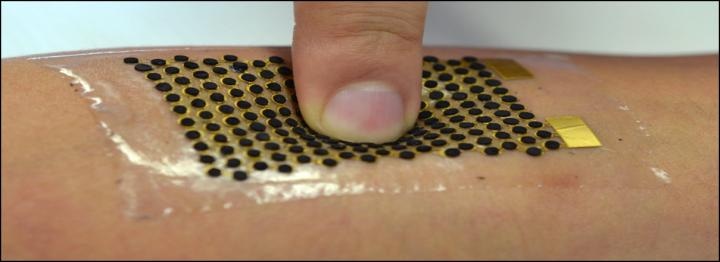Aug 23 2017
Stretchable fuel cells capable of extracting energy from sweat and also powering electronics, such as Bluetooth radios and LEDs, have been developed by a team of Engineers.
The biofuel cells produce 10 times more power per surface area than any of the wearable biofuel cells that are currently available. The devices can be used for powering a variety of wearable devices.
 The biofuel cell can stretch and flex, conforming to the human body. CREDIT University of California San Diego
The biofuel cell can stretch and flex, conforming to the human body. CREDIT University of California San Diego
The epidermal biofuel cells are considered to be a significant breakthrough in the field, which has been striving hard to develop devices that are powerful enough and stretchable enough. Thanks to a combination of electronic interfaces, advanced materials and clever chemistry, Engineers from the University of California San Diego succeeded in achieving this breakthrough. This allowed them to construct a stretchable electronic foundation by employing lithography and also screen-printing in order to produce 3D carbon nanotube-based cathode and anode arrays.
The biofuel cells comprise of an enzyme capable of oxidizing the lactic acid present in human sweat in order to produce current. This converts the sweat into a source of power.
The results have been reported by Engineers in the June edition of Energy & Environmental Science. In this paper, the Engineers explain how they attached the biofuel cells to a custom-made circuit board and further demonstrated the capability of the device to power an LED while a person wearing the device exercised on a stationary bike. Professor Joseph Wang, who directs the Center for Wearable Sensors at UC San Diego, headed the research, in association with Electrical Engineering Professor and Center Co-director Patrick Mercier and Nanoegnineering Professor Sheng Xu, both also at the Jacobs School of Engineering UC San Diego.
Islands and bridges
It is essential for the biofuel cell to be stretchable and flexible in order to be compatible with wearable devices. Thus, Engineers decided to use a "bridge and island" structure produced in Xu's research group. The cell is basically made up of rows of dots, wherein each is connected by spring-shaped structures. Half of the dots make up the cell's cathode; and the other half of the dots make up the anode. The spring-like structures are capable of stretching and bending, allowing the cell to be flexible without deforming the cathode and anode.
The basis for the structure of the islands and bridges was developed through lithography and is made of gold. As part of a second step Researchers made use of screen printing in order to deposit layers of biofuel materials on top of the cathode and anode dots.
Increasing energy density
The biggest challenge faced by the Researchers was associated with increasing the energy density of the biofuel cell, meaning the amount of energy it can produce per surface area. Increasing energy density is considered to be key to enhancing the performance for the biofuel cells. The cells become more powerful based on the increasing amounts of energy generated by them.
"We needed to figure out the best combination of materials to use and in what ratio to use them," said Amay Bandodkar, one of the paper's First Authors, who was at that time a Ph.D. Student in Wang's research group. He is presently a Postdoctoral Researcher at Northwestern University.
Engineers increased power density by screen printing a 3D carbon nanotube structure on top of the cathodes and anodes. The structure allows Engineers to load individual anodic dots with more of the enzyme that reacts to silver oxide and lactic acid at the cathode dots. Additionally, the tubes enable effortless electron transfer, which enhances the performance of the biofuel cell.
Testing applications
The biofuel cell was attached to a customized circuit board developed in Mercier's research group. The board is a DC/DC converter that evens out the power produced by the fuel cells, which fluctuates with the volume of sweat generated by a user, and then changes it into a constant power with a constant voltage.
Four subjects were equipped with the biofuel cell-board combination and the Researchers made these subjects exercise on a stationary bike. For about four minutes, the subjects were able to power a blue LED.
Next steps
Future work is required in two areas. First, the silver oxide employed at the cathode is light sensitive and gets damaged over time. Researchers will have to find a material that is more stable in the long run.
The concentration of lactic acid in the sweat generated by an individual gets diluted over time. This is the reason why subjects were able to light up an LED for just four minutes while biking. The team is currently exploring a way that will help store the energy generated while the concentration of lactate is adequately high and then gradually release it.